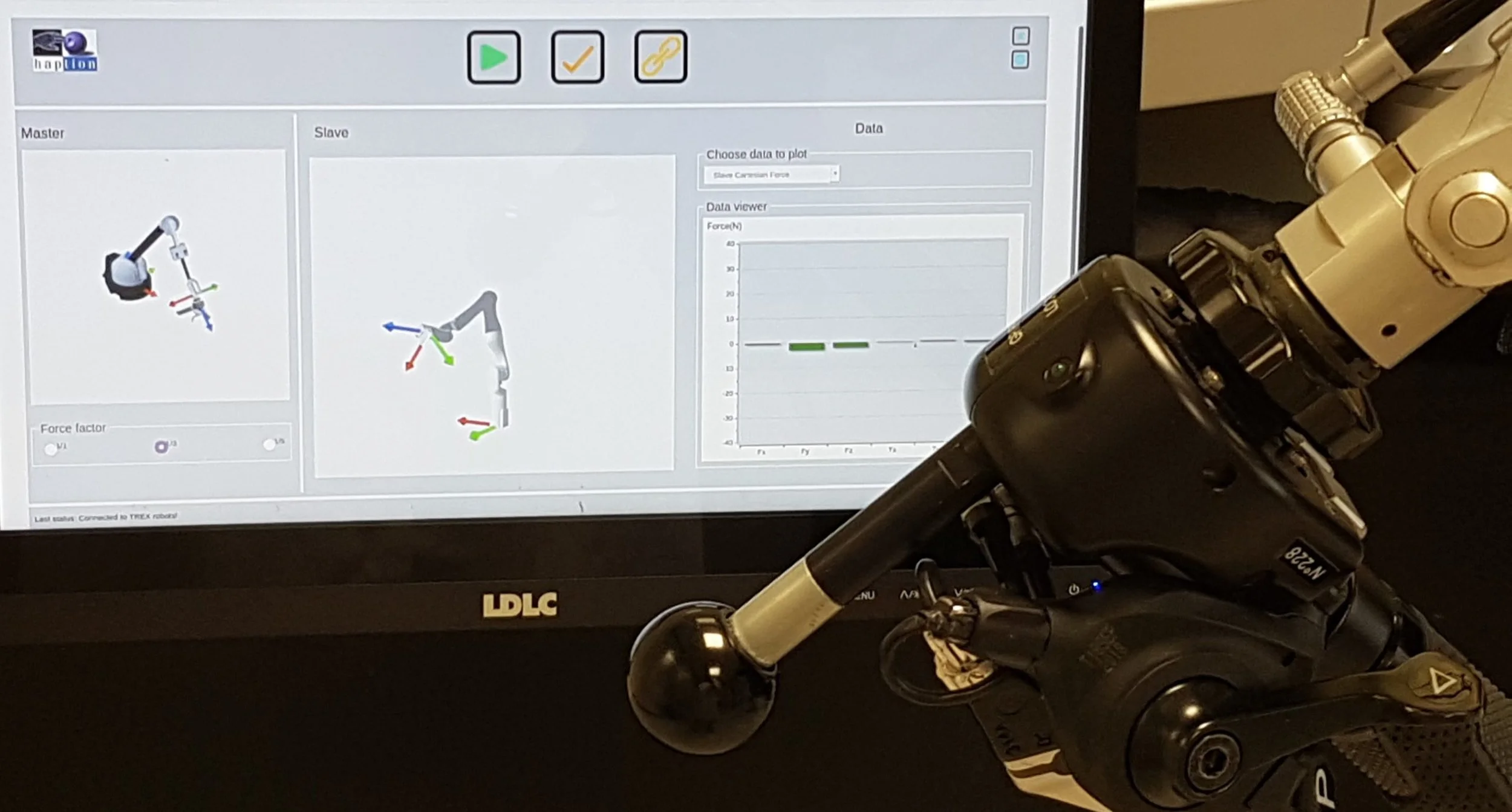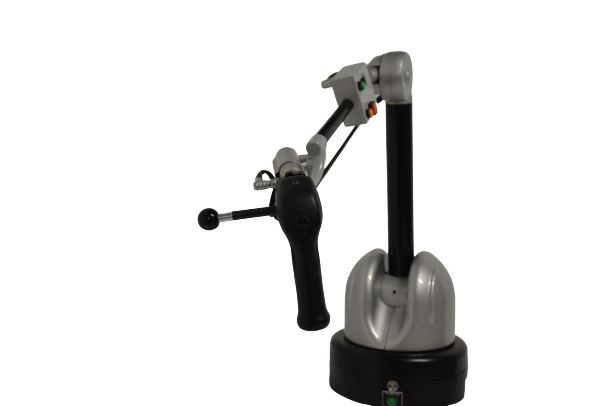Telerobotics
Force-feedback manipulators for remote handling
HARDWARE
Force-feedback manipulator family Virtuose 6D TAO
The Virtuose 6D TAO is a derived version of the Virtuose 6D VR haptic device, adapted specifically for the robotic and teleoperation markets. It is equipped with an extra button box, an ergonomic handle and uses either the Ethernet or EtherCAT communication protocol.
The Virtuose 6D TAO benefits from the technological excellence and the extreme robustness of the Virtuose 6D VR, and is specially adapted to the needs of remote handling applications: bilateral control in Cartesian space, one hand and two hands usage, heavy objects handling, 3D simulation for training and mission planning.
Virtuose™ 6D HF TAO
This force-feedback manipulator was developed in collaboration with our customers, to answer the needs of teleoperation and remote handling applications. The Virtuose 6D TAO devices have proven their robustness with unmatched field experience for haptic devices. They already count many thousands of hours of operation and keep proving their reliability in the long run by being used on a daily basis for telerobotic operations and processes.
The Virtuose 6D TAO High Force provides three times the level of force-feedback available on the standard version. It is a version predestined for applications demanding a very high level of force-feedback. This additional power is necessary for controlling robots with a payload capacity greater than 6 kg. It is well suited to control robots like Universal Robot UR10e/UR16e/UR20/UR30, KUKA KR, FANUC, Stäubli TX2, Kawasaki, ABB, Yaskawa, Comau, or any other industrial robot as well as specific ruggedized robots.
The Virtuose 6D TAO High Force is also compatible with our range of software solutions, which allow you to directly use the device in CAD software to perform assembly simulation and in 3D game engines to generate even more realistic immersive experiences.
Virtuose™ 6D TAO
This force-feedback manipulator was developed in collaboration with our customers, to answer the needs of teleoperation and remote handling applications. The Virtuose 6D TAO devices have proven their robustness with unmatched field experience for haptic devices. They already count many thousands of hours of operation and keep proving their reliability in the long run by being used on a daily basis for telerobotic operations and processes.
More dedicated to piloting small robots such as the Kinova Gen3 or the Universal Robot UR3e and UR5e, the Virtuose 6D TAO has great transparency which provides the operator with a very precise force-feedback.
The Virtuose 6D TAO is also compatible with our range of software solutions, which allow you to directly use the device in CAD software to perform assembly simulation and in 3D game engines to generate even more realistic immersive experiences.
SOFTWARE
Telerobotic framework for connecting the force-feedback manipulator to the robots
TeleRobotics EXtender™
TeleRobotics EXtender (TREX) is a force-feedback telerobotics framework. It provides an innovative solution for all cases where people work in hazardous, arduous or otherwise constrained environments, allowing them to perform their tasks without exposing themselves to any risk. With TREX, the operator is able to control the remote robot manually, with a high dexterity and precision, while perceiving the forces at play thanks to the force-feedback manipulator Virtuose.
The system is called a telerobotic solution and consists of a force-feedback manipulator (Haption), a robot (third-party vendor) and an application (Haption). The manipulator is installed, depending on the use-case, near or far from the robot. Through the application, the user drives the robot remotely, in real time and without prior programming.
The use of a force-feedback manipulator allows the operator to feel both the dynamics of the robot, and the forces applied by it. The sensation of force is essential to reduce the risk of damage to the environment or the robot itself. The robot reproduces faithfully the movements of the manipulator, as if it’s an extension of the operator’s hand.
The operator carries out his/her work comfortably, retaining all his manual abilities, without being exposed to the dangerous or constraining environment. Thanks to the manipulator, the user feels the dynamics of the robot, as well as the weight of the objects grasped, the possible collisions, etc. A set of buttons allow him/her to vary the scale of forces and movements of the robot.
In short, TREX is a perfect solution for:
Reducing the exposure of the operator to environmental risks
Controlling precisely the robot movements and enhancing the operator’s dexterity
Taking full advantage of the operator’s manual skills and cognitive abilities
Keeping the human operator in charge for all decisions
With TREX, the operators can apply their know-how and manual expertise through the robot, without any offline programming being required.
What is haptics for telerobotics?
Telerobotics is the area of robotics concerned with the control of semi-autonomous robots from a distance (source: Wikipedia). It is defined as the combination of teleoperation and telepresence. The first part, teleoperation, enables an operator to remote control a robot. The second part, telepresence, gives the operator the ability to “sense” the robot in its interaction with its environment. With the help of force-feedback, the operator is aware of the forces at play in the remote site, especially the inertia and friction of the robot, the weight of the tools, the robot joint limits, the collisions with obstacles, and the action of the robot on other objects. Force-feedback telerobotics is only possible with a force-feedback manipulator.


